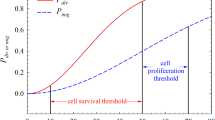Abstract
A hybrid discrete-continuum model of tumor growth in the avascular phase considering capillary points is established. The influence of the position of capillary points on tumor growth is also studied by simulation. The results of the dynamic tumor growth and the distribution of oxygen, matrix-degrading enzymes, and extracellular matrix-concentration in the microenvironment with respect to time are shown by graphs. The relationships between different oxygenated environments and the numbers of surviving, dead, proliferative, and quiescent tumor cells are also investigated.
Similar content being viewed by others
References
Stetler-Stevenson, W. G., Aznavoorian, S., and Liotta, L. A. Tumor cell interactions with the extracellular matrix during invasion and metastasis. Annu. Rev. Cell Biol., 9, 541–573 (1993)
Bru, A., Pastor, J. M., and Berenguer, C. Super-rough dynamics on tumor growth. Phys. Rev. Lett., 81, 4008–4011 (1998)
Castro, M., Molina-Paris, C., and Deisboeck, T. S. Tumor growth instability and the onset of invasion. Phys. Rev. E, 72, 041907 (2005)
Jbabdi, S., Mandonnet, E., Duffau, H., Capelle, L., Swanson, K. R., Pelegrini-Issac, M., Guillevin, R., and Benali, H. Simulation of anisotropic growth of low-grade gliomas using diffusion tensor imaging. Magn. Reson. Med., 54, 616–624 (2005)
Khain, E. and Sander, L. M. Dynamics and pattern formation in invasive tumor growth. Phys. Rev. Lett., 96, 188103 (2006)
Araujo, R. P. and McElwain, D. L. S. A linear-elastic model of anisotropic tumor growth. Eur. J. Appl. Math., 15, 365–384 (2004)
Araujo, R. P. and McElwain, D. L. S. A mixture theory for the genesis of residual stress in growing tissues I: a general formulation. SIAM J. Appl. Math., 65, 1261–1284 (2005)
Araujo, R. P. and McElwain, D. L. S. A mixture theory for the genesis of residual stress in growing tissues II: solutions to the biphasic equations for a multicell spheroid. SIAM J. Appl. Math., 66, 447–467 (2005)
Chaplain, M. A. J. and Lolas, G. Mathematical modelling of cancer cell invasion of tissue: the role of the urokinase plasminogen activation system. Math. Modell. Methods Appl. Sci., 15, 1685–1734 (2005)
Drasdo, D., Kree, R., and McCaskill, J. S. Monte Carlo approach to tissue-cell populations. Phys. Rev. E, 52, 6635–6657 (1995)
Turner, S. and Sherratt, J. A. Intercellular adhesion and cancer invasion: a discrete simulation using the extended Potts model. J. Theor. Biol., 216, 85–100 (2002)
Alarcon, T., Byrne, H. M., and Maini, P. K. A cellular automaton model for tumour growth in homogeneous environment. J. Theor. Biol., 225, 257–274 (2003)
Lee, D. S. and Rieger, H. Flow correlated percolation during vascular remodeling in growing tumors. Phys. Rev. Lett., 96, 058104 (2006)
Mansury, Y., Kimura, M., Lobo, J., and Deisboeck, T. S. Emerging patterns in tumor systems: simulating the dynamics of multicellular clusters with an agent-based spatial agglomeration model. J. Theor. Biol., 219, 343–370 (2002)
Athale, C., Mansury, Y., and Deisboeck, T. S. Simulating the impact of a molecular ‘decisionprocess’ on cellular phenotype and multicellular patterns in brain tumors. J. Theor. Biol., 233, 469–481 (2005)
Bartha, K. and Rieger, H. Vascular network remodeling via vessel cooption, regression and growth in tumors. J. Theor. Biol., 241, 903–918 (2006)
Ferreira, S. C., Martins, M. L., and Vilela, M. J. Reaction-diffusion model for the growth of avascular tumor. Phys. Rev. E, 65, 021907 (2002)
Jiang, Y., Pjesivac-Grbovic, J., Cantrell, C., and Freyer, J. P. A multiscale model for avascular tumor growth. Biophys. J., 89, 3884–3894 (2005)
Anderson, A. R. A. A hybrid mathematical model of solid tumor invasion: the importance of cell adhesion. Math. Med. Biol., 22, 163–186 (2005)
Anderson, A. R. A., Weaver, A. M., Cummings, P. T., and Quaranta, V. Tumor morphology and phenotypic evolution driven by selective pressure from the microenvironment. Cell, 127, 905–915 (2006)
Gerlee, P. and Anderson, A. R. A. An evolutionary hybrid cellular automaton model of solid tumor growth. J. Theor. Biol., 246, 583–603 (2007)
Kim, Y., Stolarska, M. A., and Othmer, H. G. A hybrid model for tumor spheroid growth in vitro, I. theoretical development and early results. Math. Models Meth. Appl. Sci., 17, 1773–1798 (2007)
Ramis-Conde, I., Chaplain, M. A. J., and Anderson, A. R. A. Mathematical modeling of cancer cell invasion of tissue. Math. Comput. Model., 47, 533–545 (2008)
Cai, Y., Xu, S. X., Wu, J., and Long, Q. Coupled modeling of tumour angiogenesis, tumor growth and blood perfusion. J. Theor. Biol., 279(1), 90–101 (2011)
Cai, Y., Xu, S. X., Wu, J., Long, Q., and Yao, W. Numerical simulation of inhibiting effects on solid tumour cells in anti-angiogenic therapy: application of coupled mathematical model of angiogenesis with tumour growth. Appl. Math. Mech. -Engl. Ed., 32(10), 1287–1296 (2011) DOI 10.1007/s10483-011-1500-9
Deisboeck, T. S., Wang, Z. H., Macklin, P., and Cristini, V. Multiscale cancer modeling. Annu. Rev. Biomed. Eng., 13, 127–155 (2011)
Calabresi, P. and Schein, P. S. Medical Oncology, 2nd ed., McGraw-Hill, New York (1993)
Casciari, J. J., Sotirchos, S. V., and Sutherland, R. M. Variations in tumor cell growth rates and metabolism with oxygen concentration, glucose concentration, and extracellular pH. J. Cell. Physiol., 151, 386–394 (1992)
Author information
Authors and Affiliations
Corresponding author
Additional information
Project supported by the National Natural Science Foundation of China (Nos. 10372026 and 10772051), the Shanghai Leading Academic Discipline Project (No. B112), and the Eleventh Innovation Fund for Graduate Students of Fudan University
Rights and permissions
About this article
Cite this article
Lyu, J., Xu, Sx., Yao, W. et al. Hybrid discrete-continuum model of tumor growth considering capillary points. Appl. Math. Mech.-Engl. Ed. 34, 1237–1246 (2013). https://doi.org/10.1007/s10483-013-1741-8
Received:
Revised:
Published:
Issue Date:
DOI: https://doi.org/10.1007/s10483-013-1741-8




